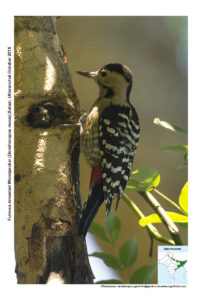Fulvous-breasted Woodpecker

Fulvous-breasted Woodpecker Dendrocopos macei
Etymology:
- Dendrocopos : Greek word dendrontree; koposstriking
- Macei: Named after French explorer Marc Joseph Macé Marion-Dufresne (1724–1772)
Distribution in India: Resident of Himalayas, East and North East in India.
Description: Size of 18–20 cm; wt. of 23–38 g. The male has buffish lower forehead, red upper forehead to nape with black feather bases showing, white lores, face and sides of neck are tinged pale buffish, and especially on ear-coverts, black malar stripe expands at rear and continues just on to upper breast side. It has a very pale dirty buffish-white chin and throat; black hindneck and upperparts, broad white bars from mantle to upper rump, wing-coverts are broadly tipped white. The black flight-feathers are barred white; uppertail is black, outer one or two feather pairs are barred white. It is light buffish-brown below, breast occasionally tinged reddish, belly and flanks are sometimes browner, breast sides and flanks are streaked blackish, lower flanks and belly sometimes barred, central lower belly to undertail-coverts are unmarked red. The long bill is straight, chisel-tipped, blackish-grey with paler base. The iris is red-brown, orbital skin is grey; legs are grey-green to greenish-slate. The female has entire top of head as black. The juvenile is duller above and below than adult, has only small area of pink on undertail-coverts.
Habitat: It is found in open, damp mixed forest in lowlands and uplands, preferring open forest, edge, secondary growth, open country with scattered trees, plantations and gardens, bamboo stands, and in scattered trees and larger bushes along dry riverbeds. It is found from Sea-level to mountains, up to 2800 m.
Food habits: It eats ants, a variety of other insects, larvae, small scorpions, berries and fruits. It stays singly or in pairs, or in family parties, also in mixed-species flocks. It favours tall trees, including isolated ones in open areas near forest. It forages on trunks and larger branches, also well up under the crown and among crown foliage on small branches and large twigs, or on the ground when seeking ants. Feeding techniques include gleaning, probing and strong pecks and hammering; also prises prey of the bark.
Breeding habits: They breed in Jan–Jun in India. They display with crest-raising, swinging movements and also fluttering aerial display. The nest-hole is excavated by both sexes above ground in branch of tree, or in bamboo. They lay a clutch of 2–5 eggs. The incubation and brood-feeding is done by both parents.